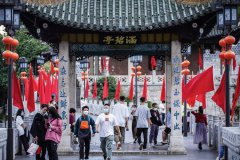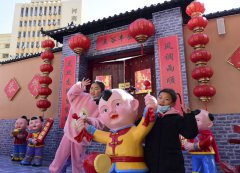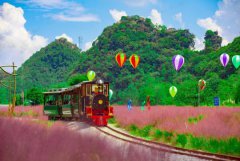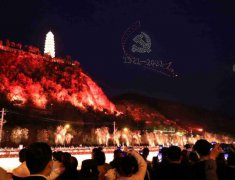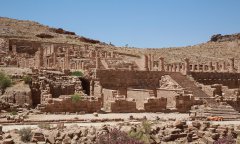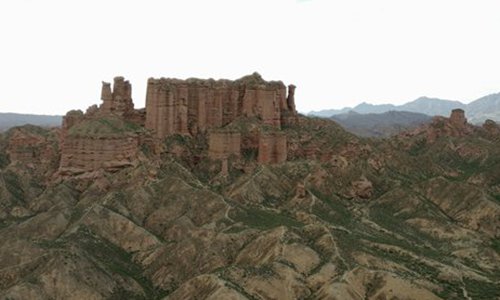
Binggou Scenic Area, Zhangye National Geopark in Gansu Province Photo: Courtesy of Rainer Feldbacher
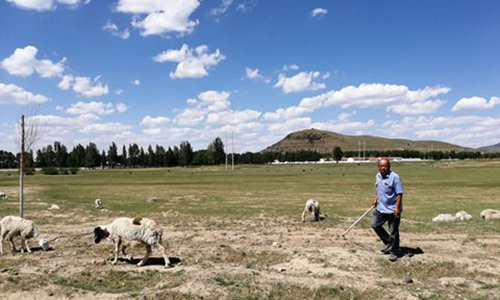
A man herds goats in the Inner MongoliaAutonomous Region. Photo: Courtesy of Rainer Feldbacher
The idea of a 6,000-kilometer road trip through northwestern China came up spontaneously during a hot pot boozing session in Beijing. One friend said that the best mutton was in the Inner Mongolia Autonomous Region, another retorted that the best mutton was in Qinghai Province. At the moment it seemed there was only one way to find out. As soon as the semester was over, seven like-minded foreigners, mostly university lecturers and English teachers, set out in two SUVs to cross deserts and traverse mountain ranges.
Lonely road
We left Beijing in the late morning, and after crossing into Inner Mongolia abandoned the highway in favor of a country road. A glance at the map, where Inner Mongolia is only a stone's throw away from Beijing, may suggest that the region is equally close to Beijing's levels of cultural and economic development. However, the opposite is true. Inner Mongolia still feels like a frontier region. Outside of tourist destinations, yurts are still used as dorms for migrant workers. Rural dwellings are rough and basic. Local people are as amazed at seeing foreigners as they probably were when Marco Polo was passing through centuries ago.
The first day on the road we nearly ran out of fuel as three service areas, modestly distanced 40-60 kilometers apart from each other, had their petrol stations closed. The canister of gasoline stashed in the trunk of the car served its purposed for the first and only time.
We spent the night in Ordos, where, according to the legend, Genghis Khan expressed his desire to be buried. The mausoleum of Genghis Khan, minus his body, is less than two hours' drive away, and is worth a short visit. The city of Ordos is new and massive and has been slowly overcoming its notoriety of a "ghost city." The outside restaurants near the main square were packed with jovial youth. Locals were friendly, and one drunken young woman kept coming to our table saying "I love you" to each member of our party, both male and female. A shy young man followed her around. He was her husband.
The next day we set out toward the northern edges of the Gobi Desert. The aim was to head westward for as long as we could in a day hoping to find a stopping place from where we could cut through the desert the following day. There wasn't much on the map that looked like a place to stop for the night. As darkness was setting in, we found ourselves on the edges of the desert with no signs of civilization other than the road we were on. Baidu Maps showed some sort of a settlement 20 kilometers away, which we managed to reach in the last minutes of the dusk. The desired "oasis" appeared in the form of a gas station and several houses on each side of the road, which served the humble needs of long-haul truckers. The proximity of the Mongolian border, only dozens of kilometers away, was highlighted by several store front signs in the Mongolian Cyrillic alphabet. The "hotel" consisted of eight rooms with three beds each and one shared toilet - the shower was locked. Our party, as spoiled as we were, occupied six of the rooms. The other two rooms hosted six truck drivers who expressed their curiosity by peeling their eyes off their smartphone screens to assess their neighbors for the night. The owner called the local police station, and two officers came over shortly. They politely inquired about the purpose of our stay and diligently inspected our documents. Afterwards the officers reminded us not to drink too much, wished us a safe journey and left. Our mutton-heavy dinner, washed down with traditional Molgolian horse-milk baijiu, extended well past midnight.
Flood of beauty
The drive through the desert started with a torrential downpour. Considering it was one of the driest places in China, we were extremely unlucky. For a couple of hours, the drive was a struggle as at some overflow areas the water was covering the hood of the car. Once the skies cleared out, the desert showed itself in full bloom. When we first saw some camels in the distance, we stopped and took hundreds of pictures. However, by the end of the day we were honking at the camels to clear the road. Portraying the desert is an insurmountable task, as the landscape changes every few kilometers from pure dunes to sand dotted with tiny shrubs, to stone hills as far as the eye can see, all with the blue sky and white clouds hanging low over the horizon. The desert was like a film that kept me on the edge of my seat for a whole day. Small detours led us to see more hidden attractions. At one instance a few minutes ride on an adjacent concrete road led us to what appeared to be a sacred religious site hidden inside a narrow gorge. A narrow stream ran through the bottom of the gorge forming small clear ponds, which reflected the sky. Two monks smiled at us and carried on with their chores as we explored the magic created by nature and a slight human touch.
The few formal sites scattered along our way were still in the development stages and completely empty of tourists. When domestic and foreign sightseers finally make their way to that remote corner of China, they will not be disappointed.
At the end of the day, as we faced the green mountains of Gansu Province, the highway toll booth attendant pointed out the absence of a front license plate on our car. As we scrolled through the day's pictures, the most plausible explanation was that the plate got ripped off by the water current during one of the deeper water crossings. For the rest of the trip we had to explain this story at every police check point. The traffic police officers patiently reminded us to report the loss, and we promised to do so when we'd get back to Beijing, which we did.
Our key destination in Gansu was the city of Zhangye, roughly in the middle of the "doggy bone" outline of the province. Gansu is commonly associated with riversides and Langzhou beef noodles or with the Mogao Grottoes, the singing sand dunes of Dunhuang and Jiayuguan, the westernmost pass through the Great Wall. In ancient times, Gansu played a key role in connecting China with the lands beyond its western frontiers. For centuries the Hexi Corridor, a natural path that stretched between the Mongolian deserts and the Tibet Plateau, served as one of the main spurs of the northern network of the Silk Road. Centuries of travelers passing through shaped the culture and social order of the region.
Gansu dwellers are polite and soft-spoken. Kids don't point fingers at outsiders and drivers yield to pedestrians. The shop owners bargain gently and willingly. The service staff is patient and eager to please.
From above
Zhangye is best known for its Rainbow Mountains a.k.a. the Colorful Danxia Scenic Spot.
The site is incredibly undersold and under-advertised. There were no lines at the tickets booths or shuttle stops and we could easily escape other people. The food and souvenir stalls were reasonably priced and free of the rip-offs that are so common at tourist traps.
A 70 yuan ($10) ticket offered access to any part of the park and provided hop-on-hop-off shuttle bus service. A few adventurous folks in our group purchased a 10-minute helicopter ride for an extra 880 yuan. Everybody in our group agreed that it was one of the most amazing natural wonders we had seen in China. The hills, generously painted in bright colors, beg for words to describe them and the views left our jaws dropped for the duration of the half day visit.
Half an hour from the Rainbow Mountains, another site, Binggou Scenic Area, presented an additional pleasant experience. The canyon, carved by a glacier, offered spectacular views, and during our nearly three-hour walk we barely encountered any people.
The airport in Zhangye provides easy access and an incredible opportunity for those looking for places not yet mobbed by crowds of tourists. The sites and the people and the proximity of the desert will leave nobody unimpressed. With the most pleasant first impression we set out the next day further south across Gansu cutting the "doggy bone" in half, heading toward the mountain passes separating us from the valleys and lakes of the Tibetan Plateau. Our question about the best mutton was still unresolved, but whatever lay beyond the mountains would have to complete with the sites and people we had passed so far.
